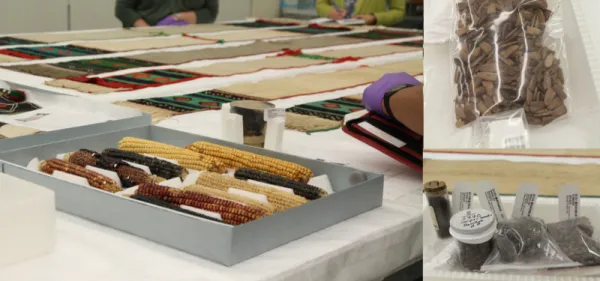
Search
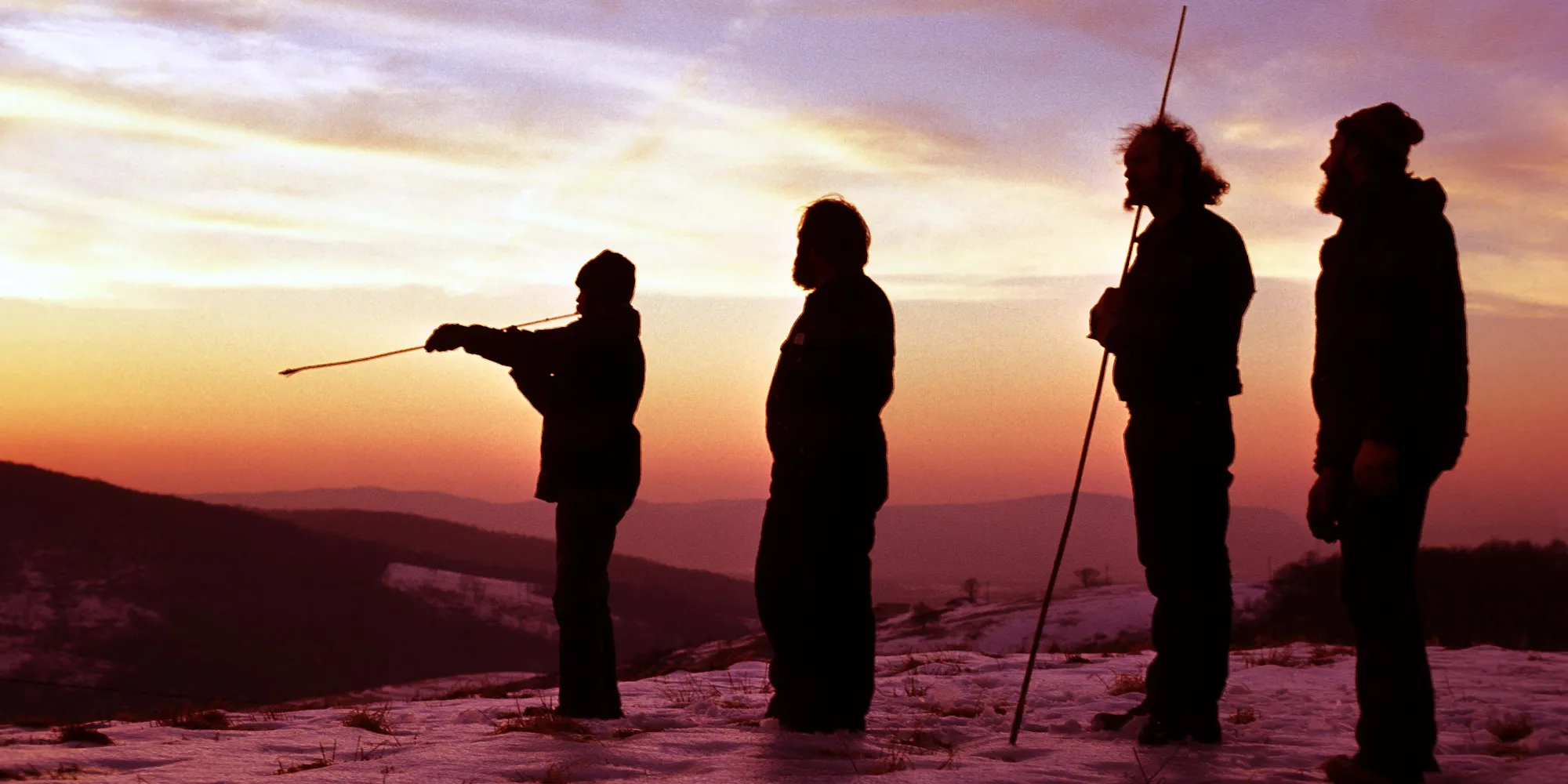
News from Recovering Voices
Growing Ancestral Zuni Knowledge
By: Keren Yairi
06/15/2017
Agriculture has always played an important role to the Zuni tribe of New Mexico. Along with hunting and gathering, detailed knowledge of how to grow food has enabled the Zuni people to survive for generations in the Southwest desert environment. Many of the traditional farming practices are becoming less common today but remain of significant interest to a group from Zuni pueblo that recently participated in the Recovering Voices Community Research Program. Studying ancestral knowledge of farming was one of the researchers’ goals during their visit to Smithsonian museum collections.

The group included three elders and a museum educator from the Zuni Cultural Resources Advisory Team (ZCRAT): Octavius Seowtewa, Raylan Edaakie, Eldred Quam, and Curtis Quam. Through the Recovering Voices program, the group spent a week researching items from their community currently held in the collections of the National Museum of the American Indian and theNational Museum of Natural History Anthropology Department. The visit also served to improve the Smithsonian’s knowledge of its own collections from Zuni perspectives.
Among the wide range of cultural artifacts the group examined, agricultural motifs were prevalent not only in the great variety of seeds, corn, and farming implements but in many of the textiles, artwork, and ceremonial objects, as well. Viewing these items elicited hours of informative descriptions and explanations, insightful questions and discussions, and evocative stories and memories among the Zuni researchers. The visit was documented for the pueblo to use in the production of educational videos to teach students and community members about traditional agriculture. The commentary included some of the uses, practices, symbolism, and importance of seeds in Zuni life.
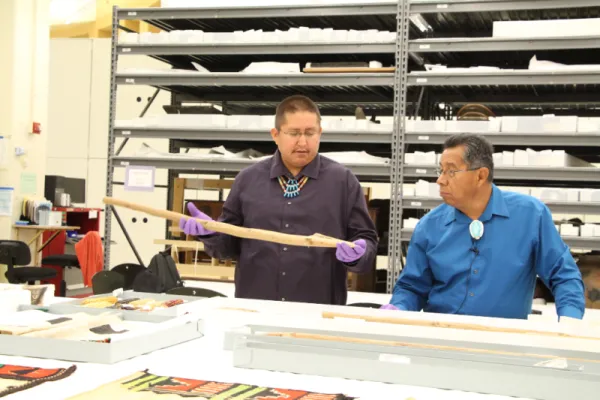
One major use of seeds for the Zuni is to grow crops. Corn, squash, and beans in particular were essential to the traditional diet. These crops were planted with digging sticks-- long, wooden poles inserted into the soil to make holes, with a small notch of wood positioned horizontally a few inches from the bottom to indicate the target depth. As each type of seed requires a different depth in the soil, specialized digging sticks were used for each crop. This implement was considered the most important tool for survival; even the native word translates to “wooden leg,” for the digging stick was as vital to Zuni farmers as their own limbs. Today, pueblo residents use modern farm equipment instead.
Some seeds are not planted for crops but are directly consumed in seed form. For example, the versatile pinion seed can be roasted and used as a flavor enhancer, and the lemony humbassa seed is often combined with salt, onions, and tomatillo in a savory sauce for deer jerky. Other seeds are reserved for ceremonial use, particularly a number of wild varieties that are highly prized because they are difficult to gather in large quantities. One such seed, identified by the rattlesnake sound made when the plant is touched, is only collected by certain individuals. Finally, some seeds have a decorative use. Tiny, fragrant juniper seeds, for instance, can be made into beads through a time-consuming process in which they are gathered, boiled, drilled with holes, dried, stranded onto thread, and incorporated with white shells to embellish bandoliers.
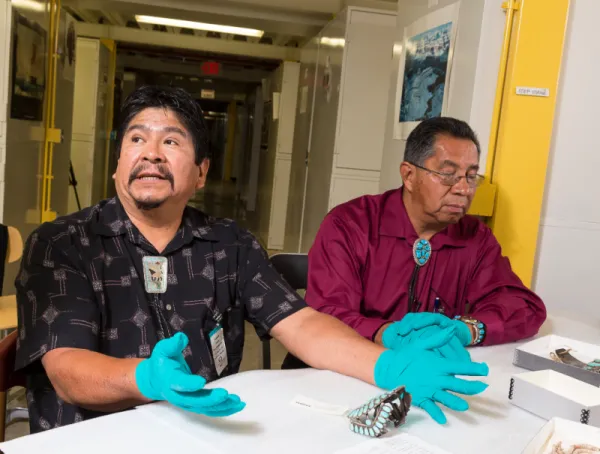
A number of rituals and practices are associated with seeds and farming, many of which are still maintained in the pueblo. For instance, there are year-round planting rituals: During the winter solstice, families gather to bless and sing to the seeds out in the fields, calling upon the ancestors to help the seeds mature in the spring; at planting time, they sing again; at harvest, they return once more to pray and dance as the stalks are taken down and the fields are put to rest until the next spring. Another practice is to plant deer meat with the crops so the plants will grow as fast as the deer runs. Zuni also avoid eating in their gardens to keep from attracting animal pests and likewise avoid eating in the communal plaza, seen as an extension of the cornfield. Jewelry-makers keep leftover scraps of shell and turquoise from their carvings to offer back to Mother Earth, while corn meal and corn pollen are given as offerings to ceremonial items.
The importance of farming to the Zuni is also evident in the predominance of agricultural motifs in textiles, tablitas (headdresses), art, and ritual objects. Sometimes, the link is direct, such as images of corn plants or carvings of Mother Corn. Other times, the link is symbolized through color, with green representing pastures and red signifying Mother Earth, or through design, such as two lines representing rain coming down and a “step” pattern indicating rain clouds. Zuni believe the energy of their clothing is transmitted through its color, shape, design, and weave. Therefore, the act of wearing textiles with these colors and designs equates to a prayer for the ancestors to send blessings of rain, a good harvest, and continued life. These wishes are not only for the individual but for the entire people and, indeed, all of humankind.
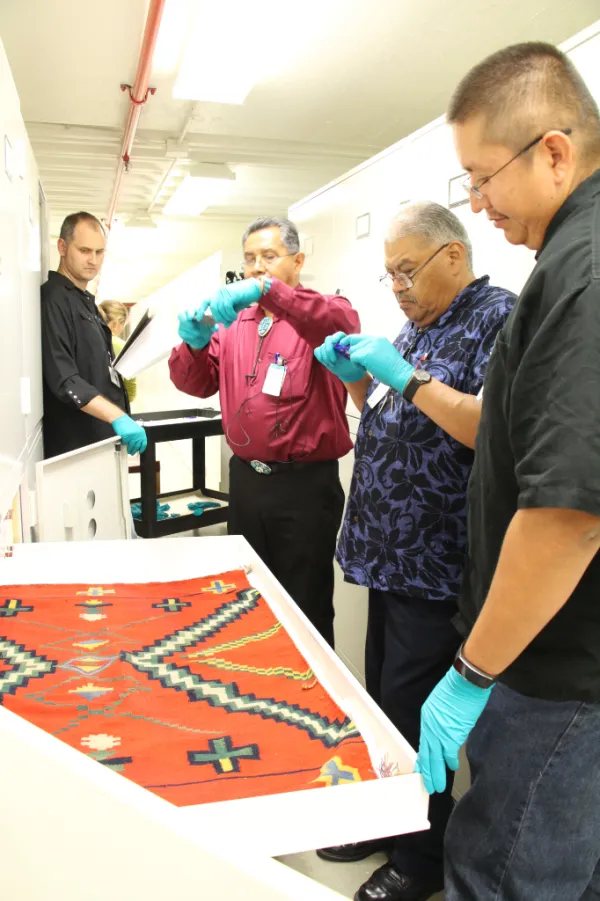
Reflecting on the visit, the participants noted how special and meaningful it was to see the agricultural objects, noting the rarity of finding these types of items today, even in museums. Tools like digging sticks have given way to modern farming implements, and much knowledge of how to work the land has gone with the older generations. The heritage varieties of seeds and corn held at the Smithsonian are still seen in Zuni, but there is concern about cross-pollination with commercial seeds. This can cause particular issues when the seeds cross with varieties that do not propagate because no plants will grow from them. The team expressed a keen interest in maintaining heritage variety seeds and admiration of their ancestors’ knowledge of how to prevent cross pollination.
Though much of traditional Zuni agriculture has been lost, the group is dedicated to preserving and revitalizing what remains. They discussed the importance of educating children and other pueblo members and began brainstorming ways to increase interest in farming again, such as by establishing a community garden in Zuni. Just as crop seeds bring the promise of food in the future, the hope is that seeds of knowledge planted by these efforts will sprout and grow a new generation of Zuni farmers.